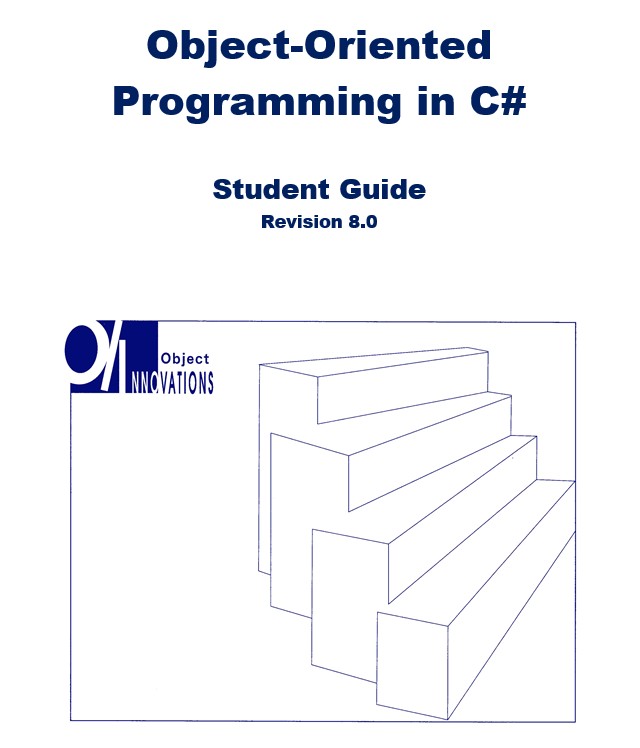
Object-Oriented Programming in C# Courseware (4001)
Microsoft .NET is an advance in programming technology that greatly simplifies application development, both for traditional, proprietary applications and for the emerging paradigm of Web-based services. .NET 8 is a unified platform, for browser, cloud, desktop, IoT, and mobile apps. It is based on .NET Core, the package-based implementation that is cross-platform, running on Mac and Linux besides Windows.
Part of this technology is the language C#. This language combines the power of C++ and the ease of development of Visual Basic 6. It bears a striking resemblance to Java and improves on that language. C# has become the dominant language for building new applications on Microsoft platforms.
This thorough and comprehensive course is a practical introduction to programming in C#, utilizing the services provided by .NET. This course emphasizes the C# language. It is current to Visual Studio 2022 and .NET. Important newer features such as dynamic data types, named and optional arguments, tuples, asynchronous programming keywords, nullable reference types, record types, and top-level statements are covered. Supplements an overview of LINQ, and coverage of unsafe code and pointers in C#.
This course is intended to be fully accessible to programmers who do not already have a strong background in object-oriented programming in C-like languages, such as C++ or Java. It is ideal, for example, for procedural programmers who desire to learn C#.
An important thrust of the course is to teach C# programming from an object-oriented perspective. It is often difficult for programmers trained originally in a procedural language to start “thinking in objects.” This course introduces object-oriented concepts early, and C# is developed in a way that leverages its object orientation. A case study is used to illustrate creating a complete system using C# and .NET. Besides supporting traditional object-oriented features, such as classes, inheritance, and polymorphism, C# introduces several additional features, such as properties, indexers, delegates, events, and interfaces that make C# a compelling language for developing object-oriented and component-based systems. This course provides thorough coverage of all these features.
C# as a language is elegant and powerful. But to utilize its capabilities fully, you need to have a good understanding of how it works with the .NET Framework. The course explores several important interactions between C# and the .NET Framework, and it includes an introduction to major classes for collections, delegates, and events. The course concludes with a chapter covering additional features in the language. Numerous programming examples and exercises are provided, including the case study. The student will receive a comprehensive set of materials, including course notes and all the programming examples.
Benefits
- Acquire a working knowledge of C# programming
- Learn how to implement programs using C# and classes from the .NET Framework
- Gain an understanding of the object-oriented programming paradigm
- Learn how to implement simple GUI programs using Windows Forms
- Gain a working knowledge of important newer features in C#
Outline
- Introduction to NET
- What is .NET?
- .NET Framework, NET Core and .NET 6
- Application Models
- Managed Code
- Visual Studio 2022
- Console Programs and New Console Template
- GUI Programs
- First C# Programs
- Hello, World
- Namespaces
- Variables and Expressions
- Using C# as a Calculator
- Input/Output in C#
- .NET Class Library
- Data Types in C#
- Data Types
- Integer Types
- Floating Point Types
- Decimal Type
- Characters and Strings
- Boolean Type
- Conversions
- Nullable Types
- Operators and Expressions
- Operator Cardinality
- Arithmetic Operators
- Relational Operators
- Logical Operators
- Bitwise Operators
- Assignment Operators
- Expressions
- Checked and Unchecked
- Control Structures
- If Tests
- Loops
- Arrays
- Foreach
- More about Control Flow
- Switch
- Object-Oriented Programming
- Objects
- Classes
- Inheritance
- Polymorphism
- Object-Oriented Languages
- Components
- Classes
- Classes as Structured Data
- Methods
- Constructors and Initialization
- Static Fields and Methods
- Constant and Readonly
- More about Types
- Overview of Types in C#
- Value Types
- Boxing and Unboxing
- Reference Types
- Implicitly Typed Variables
- Methods, Properties and Operators
- Methods
- Parameter Passing
- Method Overloading
- Variable-Length Parameter Lists
- Properties
- Auto-Implemented Properties
- Operator Overloading
- Characters and Strings
- Characters
- Strings
- String Input
- String Methods
- StringBuilder Class
- Programming with Strings
- Arrays and Indexers
- Arrays
- System.Array
- Random Number Generation
- Jagged Arrays
- Rectangular Arrays
- Arrays as Collections
- Bank Case Study—Step 1
- Indexers
- Inheritance
- Single Inheritance
- Access Control
- Method Hiding
- Initialization
- Bank Case Study—Step 2
- Virtual Methods and Polymorphism
- Virtual Methods and Dynamic Binding
- Method Overriding
- Fragile Base Class Problem
- Polymorphism
- Abstract Classes
- Sealed Classes
- Heterogeneous Collections
- Bank Case Study—Step 3
- Formatting and Conversion
- ToString
- Format Strings
- String Formatting Methods
- Bank Case Study—Step 4
- Type Conversions
- Exceptions
- Exception Fundamentals
- Structured Exception Handling
- User-Defined Exception Classes
- Inner Exceptions
- Bank Case Study—Step 5
- Interfaces
- Interface Fundamentals
- Programming with Interfaces
- Using Interfaces at Runtime
- Bank Case Study—Step 6
- Resolving Ambiguities
- .NET Interfaces and Collections
- Collections
- Bank Case Study—Step 7
- IEnumerable and IEnumerator
- Copy Semantics and ICloneable
- Comparing Objects
- Generic Types
- Type-Safe Collections
- Object Initializers
- Collection Initializers
- Anonymous Types
- Bank Case Study—Step 8
- Delegates and Events
- Delegates
- Anonymous Methods
- Lambda Expressions
- Events
- Introduction to Windows Forms
- Creating Windows Applications Using Visual Studio 2022
- Partial Classes
- Buttons, Labels and Textboxes
- Handling Events
- Listbox Controls
- Additional Features in C#
- Dynamic Data Type
- Named and Optional Arguments
- Variance in Generic Interfaces
- Asynchronous Programming Keywords
- Nullable Reference Types
- Record Types
- Top-level Statements
Appendix A. Learning Resources
Electronic File Supplements
Supplement 1. Using Visual Studio 2022
- Signing into Visual Studio
- Overview of Visual Studio 2022
- Creating a Console Application
- Project Configurations
- Debugging
- Multiple-Project Solutions
Supplement 2. Language Integrated Query (LINQ)
- What Is LINQ?
- Basic Query Operators
- Filtering
- Ordering
- Aggregation
Supplement 3. Unsafe Code and Pointers in C#
- Unsafe Code
- C# Pointer Type
System Requirements
Course examples require Microsoft Visual Studio 2022 and Windows 10 or higher. Window 11 is recommended. The free Visual Studio Community 2022 can be used. See the appropriate course Setup Guide for details.
A good minimal hardware profile for this course consists of a 2 GHz or better CPU, 4 GB of RAM and at least 10 GB of free disk space for tools installation and courseware.
Required Prerequisites
The student should have programming experience in a high-level language.
License
Length: 5
days | $200.00 per copy
What is Included?
- Student Manual
- Student Class Files
- Extra Trainer Files
- PowerPoint Presentation
